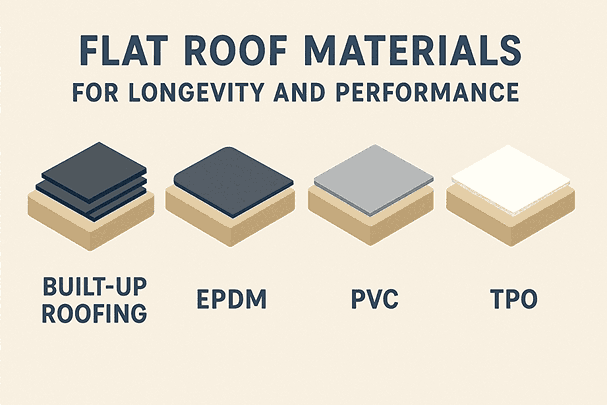
Top 7 Flat Roof Materials for Longevity and Performance
Wondering which materials work best for flat roofs in Florida? Choosing the right roofing material is essential. It impacts durability, energy efficiency, and long-term maintenance costs. This is especially important for flat roofs in Florida, where heat, humidity, and storms are common challenges.
Flat roofs are a popular choice in modern design. They offer clean lines and usable space. However, their structure demands thoughtful material selection.
Below is a breakdown of the 7 best flat roof materials. Each section includes key pros, cons, and why they are ideal for flat roofs in Florida.
1. Built-Up Roofing (BUR)
BUR is one of the oldest roofing systems. It’s made from layers of bitumen and reinforcing fabrics. These layers are topped with gravel or a cap sheet.
Pros:
- Excellent waterproofing due to multiple layers.
- Strong resistance to foot traffic and minor impacts.
- Cost-effective over its lifespan.
Cons:
- Heavy material that may need additional structural support.
- Installation is labor-intensive and can be messy.
- Offers limited insulation unless paired with other materials.
Why It Works for Flat Roofs in Florida:
BUR performs well in Florida’s wet climate. Its layered design provides strong protection against water. However, proper installation is essential to maximize its benefits.
2. Modified Bitumen Roofing
Modified bitumen is an enhanced version of BUR. It includes polymer-modified asphalt sheets that offer greater flexibility.
Pros:
- Easy to install using various methods like torch-down or cold-applied adhesives.
- Durable and resists cracking under temperature changes.
- Better flexibility than traditional BUR.
Cons:
- May be punctured by sharp objects or heavy debris.
- Requires regular inspections to maintain integrity.
Why It Works for Flat Roofs in Florida:
EPDM handles high UV exposure very well. It’s a cost-effective solution for flat roofs in Florida. Regular maintenance helps extend its life.
3. Single-Ply Membrane Roofing (EPDM, TPO, PVC)
These membranes are widely used for flat roofs. Each type offers specific advantages. EPDM is rubber-based. TPO and PVC are thermoplastic materials.
Pros:
● Lightweight and easy to install.
● Some options (like TPO and PVC) offer excellent UV resistance.
● Energy-efficient due to reflective surfaces.
Cons:
● Seams must be sealed properly to avoid leaks.
● Membranes can be punctured by tools or debris.
Why It Works for Flat Roofs in Florida: TPO and PVC membranes reflect sunlight. This keeps buildings cooler. Their durability and energy savings make them ideal for flat roofs in Florida.
4. Metal Roofing
Though often used for sloped roofs, certain metal systems work for flat surfaces. These include standing seam panels designed for low-slope applications.
Pros:
● Long-lasting and highly durable under extreme weather.
● Reflects sunlight, reducing cooling costs.
● Requires little maintenance once installed.
Cons:
● High initial installation cost.
● May be noisy during storms without proper insulation.
Why It Works for Flat Roofs in Florida: Metal roofs are strong and weather-resistant. Their reflective nature helps combat Florida’s heat. For flat roofs in Florida, metal is a solid long-term investment.
5. Green Roofs
Green roofs use a waterproof membrane covered with soil and plants. They create a living environment on top of buildings.
Pros:
● Excellent natural insulation.
● Reduces heat island effect and improves air quality.
● Visually appealing and adds usable space.
Cons:
● High cost of installation and ongoing maintenance.
● Requires strong structural support and proper drainage.
Why It Works for Flat Roofs in Florida: Florida’s warm climate supports plant growth year-round. Green roofs reduce cooling needs and support sustainability. This makes them an eco-friendly choice for flat roofs in Florida.
6. Rubber Roofing (EPDM)
EPDM is a synthetic rubber material. It is used widely due to its durability and ease of use.
Pros:
● Lightweight and quick to install.
● UV-resistant and weather-tolerant.
● Long lifespan with proper maintenance.
Cons:
● It can be punctured by sharp tools or debris.
● Seams require periodic sealing to prevent leaks.
Why It Works for Flat Roofs in Florida: EPDM handles high UV exposure very well. It’s a cost-effective solution for flat roofs in Florida. Regular maintenance helps extend its life.
7. Spray Polyurethane Foam (SPF)
SPF is a spray-applied roofing system. It expands into a foam that creates a seamless barrier.
Pros:
● Provides excellent insulation and waterproofing.
● Fills cracks and conforms to any shape.
● Lightweight and seamless, reducing leak risks.
Cons:
● Needs professional installation.
● Must be coated to protect from UV rays.
Why It Works for Flat Roofs in Florida:
SPF keeps heat out and energy bills down. It also prevents water intrusion. That’s essential for flat roofs in Florida, where storms can be intense.
Final Thoughts
Flat roofs are modern, efficient, and versatile. But they require the right materials to perform well. From rubber to foam to green options, there’s a solution that fits your needs and budget. Make an informed choice to ensure your flat roof lasts and delivers real value.Contact Keeping You Dry Roofing for professional guidance and installation services tailored to flat roofs in Florida.